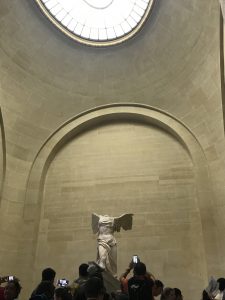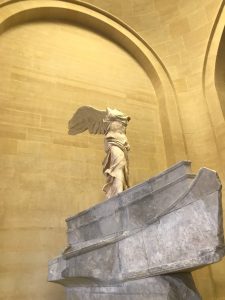‘Winged Victory of Samothrace’, approx. 190 BC
Also known as the ‘Nike of Samothrace’, is a Hellenistic sculpture of the winged female figure, Nike, the goddess of victory. The missing features, such as the head and the arms, adds to the mystery and mythology behind the God; with no face the distinctive figure is now the wings. The motion of the wings combined with the flowing fabric look covering the figure, falling at her feet, gives the work a delicate but powerful atmosphere. It reflects on the mythology as Nike was commonly shown flying down from Mount Olympus. This intensity of movement also adds to the belief that the statue was positioned at the prow of the ship, leading them to victory with the wind flowing past her. This all builds a powerful sense of action and triumph, as well as a delicateness from the fabric.
When I saw this piece back in August, it was positioned at the top of a large staircase, giving it a huge vantage point for the public to see it. I could see it from the opposite end of the long corridor leading up to it; as I walked towards it and climbed the stairs, the intensity and beauty of the piece only grew stronger. It’s placement also allows it to be viewed at different angles, each one adding a new majestic feeling. Front on, I became engulfed in the powerful and triumphant atmosphere it created because of the strong body language the figure was emitting combined with the large wings protruding behind her. From side on however, you’re allowed to see the enormity of those wings and how majestic they are. Also you can see the action running through the piece with the fabric as it falls behind her and billows between her legs.



